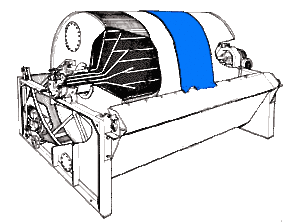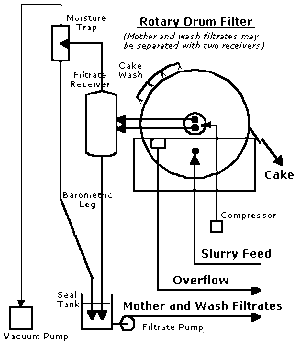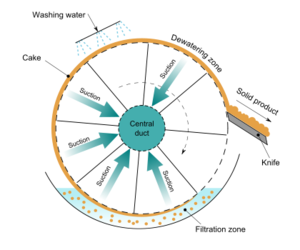Filter Drums
The Rotary Vacuum Filter Drums belongs to the bottom feed group and is one of the oldest filters applied to the chemical process industry.
The filter consists of the following subassemblies:
The Drum
The drum is supported by a large diameter trunion on the valve end and a bearing on the drive end. The drum face is divided into circumferential sectors each forming a separate vacuum cell. The internal piping that is connected to each sector passes through the trunion and ends up with a wear plate having ports that correspond to the number of sectors.
The Valve
A valve with a bridge setting controls the sequence of the cycle so that each sector is subjected to vacuum, blow and a dead zone. When a sector enters submergence vacuum commences and continues through washing, if required, to a point that it is cut-off and blow takes place to assist in discharging the cake.
The valve has on certain filters adjustable blocks and on others a fixed bridge ring. Adjustable bridge blocks enable the optimization of form to dry ratio within the filtration cycle as well as the "effective submergence" of the drum when the slurry level in the tank is at the maximum.
The majority of drum filters have a valve with three bridge blocks and a single row pipe plate as shown below and on the right. The duty of the bridges is:
1.Vacuum and blow zones separating bridge. This bridge cuts off the vacuum so it is slightly wider than the internal pipe port.
2.Dead zone bridge. This bridge opens to vacuum once a compartment submerges.
3. Start-up assist bridge. At start-up the upper vacuum zone is open to atmosphere and a cake may be formed only when closing the valve that controls this zone. Once the cake starts to emerge from the tank the valve is gradually opened and fully opened when the entire drum face is wrapped with the cake. Since in continuous operation both lower and upper zones are under vacuum this bridge is slightly narrower than the internal pipe port so that the vacuum is continuous and the cake is held onto the drum.
However, there are also more complex drum filters such as lube oil dewaxers. These filters have a sophisticated valve that allows very quick evacuation of residual wash liquid from the descending compartments by purging inert gas through the internal piping manifold prior to cake discharge.
The Drum Deck
The drum deck is divided into separately isolated compartments each subjected to vacuum or blow while the drum is in rotation. The timing of vacuum or blow depends on the bridge setting of the main valve. The compartments are divided with grooved division strips along the drum face and around the circumference of the drum heads. These division strips are holding synthetic grids shown on the right that cover the entire drum and serve to support the filter cloth. The filter cloth itself is fastened to the drum face by inserting special caulking ropes into the grooves.
Selection Criteria
In broad terms drum filters are suitable to the following process requirements:
- Slurries with solids that do not tend to settle rapidly and will remain in a uniform suspension under gentle agitation.
- Cakes when a single washing stage is sufficient to remove residual contaminants from the cake or yield maximum recovery of filtrate.
- Cakes which do not require long drying times to reach asymptotic moisture values.
- Filtrates that generally do not require a sharp separation between the mother and wash filtrates. Some complex valves, however, enable atmospheric purging of the sectors and internal piping to facilitate a sharp separation of filtrates.
- Filtrates that are acceptable with a low quantity of fines that pass trough the filter cloth in the first few seconds of cake formation. Broadly, and depending on particle size and cloth permeability, the filtrate may contain 1000 to 5000 ppm insolubles.
- For very corrosive applications plastic drum filters are available with up to 10-15 m2 filtration area.
Maintenance
The slow rotation of the drum and reciprocation of the agitator reduce maintenance requirements to a minimum but the following should be inspected periodically:
- The strip liner of the trunnion bearing at the valve end will normally wear at the lower half. However, in cases when the slurry has a high specific gravity, the drum may become buoyant causing a wear to the upper half. At this point it should be mentioned that one way to remove the lower half of the liner, when hoisting facilities are not available or operational, is to float the drum by filling the tank with a sufficiently concentrated solution.
- The stuffing boxes on high submergence filters should be inspected for leakage and, if necessary, the stud nuts should be tightened. It should be noted that excess tightening can increase substantially the load on the drum drive so the use of a torque wrench is recommended.
- The face of the wear plate should be checked periodically and remachined if necessary. A whistling noise during operation is an indication the wear plate is worn out or the valve spring requires tensioning.
- The drum has a bailer tube that protrudes from the drive end shaft and must be kept open to atmosphere at all times since its blockage may cause the collapse of the drum. The bailer tube is a tell-tale indication to the following:
- If a lighter flame is drawn through the bailer tube to the inside of the drum it indicates that a vacuum leak exists in the drum shell or the internal piping. It should be noted that in certain instances there is a possibility that explosive gases build-up inside the drum and may pose a safety hazard. In such cases the use of aerosol type smokes or a light tissue paper should be used instead of an open flame to identify a vacuum leak.
- If liquid leakage is observed from the bailer tube it indicates that a hole exists in the drum head causing penetration of slurry from the tank into the drum.
- The on-line filter on the wash headers manifold should be checked periodically for pressure build-up due to progressive blockage. Likewise, the nozzles on the wash headers should be kept clean in order to ensure overlapping for full coverage of the washed cake.
Video


